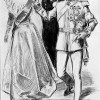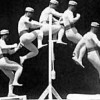
Nicholas Daly, “Anthony Hope’s The Prisoner of Zenda (April, 1894) and the Rise of Ruritanian Fiction”
Anthony Hope’s bestseller of 1894, The Prisoner of Zenda, inspired a subgenre of adventure romances set in imaginary, semi-feudal European countries, of which Ruritania is the original. English and later American protagonists stumble into plot-driven narratives that usually feature some combination of schemes against the throne, doubles or mistaken identities, swordplay, and love at first sight. Since the 1890s, Ruritanian backdrops have been reworked for a variety of purposes, from Balkan spy novels, to interwar operetta, to Cold War satires, in such fictional territories as Ixania, Krasnia, and Grand Fenwick.

Garrett Stewart, “Curtain Up on Victorian Popular Cinema; Or, The Critical Theater of the Animatograph”
Hard on the heels of the Lumière “Cinématographe” in its Paris debut, the West End appearance of its most successful British equivalent, Robert W. Paul’s “Animatograph,” brought the apparatus for moving-image projection before a British public that would soon flock to its display of miscellaneous short films in theatrical venues all across England, propelling a widespread Victorian fascination with the new medium of visual spectacle and eventual (edited) storytelling, the latter in narrative formats by turns comic, melodramatic, and fantastic. In these emergent genre bearings alone, here was an entertainment technology that looked back into the earlier Victorian period as well as forward to both popular and experimental modernism. Much recent commentary has aimed at connecting this next-century destiny not just to the medium’s Victorian technological origins but to cultural orientations—and literary prototypes—in nineteenth-century habits of attention and imagination.
